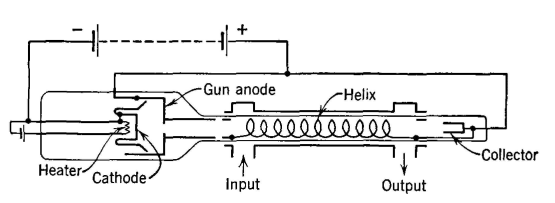| Electrical Communication is a free textbook on the basics of communication technology. See the editorial for more information.... |

|

Home  Electronic Applications in Communication Electronic Applications in Communication  Traveling-Wave Amplifier Tube Traveling-Wave Amplifier Tube |
|||






|
|||
Traveling-Wave Amplifier TubeThe electron gun of Fig. 41 shoots an electron beam through a wire helix. The electrons are maintained in a beam by constant magnetic fields produced by the focusing coils. The signal to be amplified is introduced into the traveling-wave tube38 by a wave guide. This induces a signal voltage in the left end of the helix, and this voltage causes an electromagnetic wave to travel down the helix toward the right end. The velocity of this wave along the axis of the tube is much slower than along a straight wire, because the current component must flow around the turns of the helix. The tube is operated so that the velocity of the electron beam is slightly greater than the velocity of the wave along the tube axis. Under these conditions the traveling wave will absorb energy from the electron beam, and signal amplification will result. When the amplified signal wave reaches the right end of the tube, the signal energy is transferred from the helix to the wave-guide output.
The traveling-wave tube has an outstanding characteristic. It will amplify over the very wide frequency range of 800 megacycles, the bandwidth limits being the usual -3 decibels at the upper and lower frequencies. Furthermore, this tube operates at the ultrahigh and superhigh frequencies of several thousand megacycles. This tube, in the form described or in a modified form with the helix omitted,39 may prove revolutionary in such applications as point-to-point radio, because of the very wide band that it will pass.
|
|||
Home  Electronic Applications in Communication Electronic Applications in Communication  Traveling-Wave Amplifier Tube Traveling-Wave Amplifier Tube |
|||
Last Update: 2011-04-06


